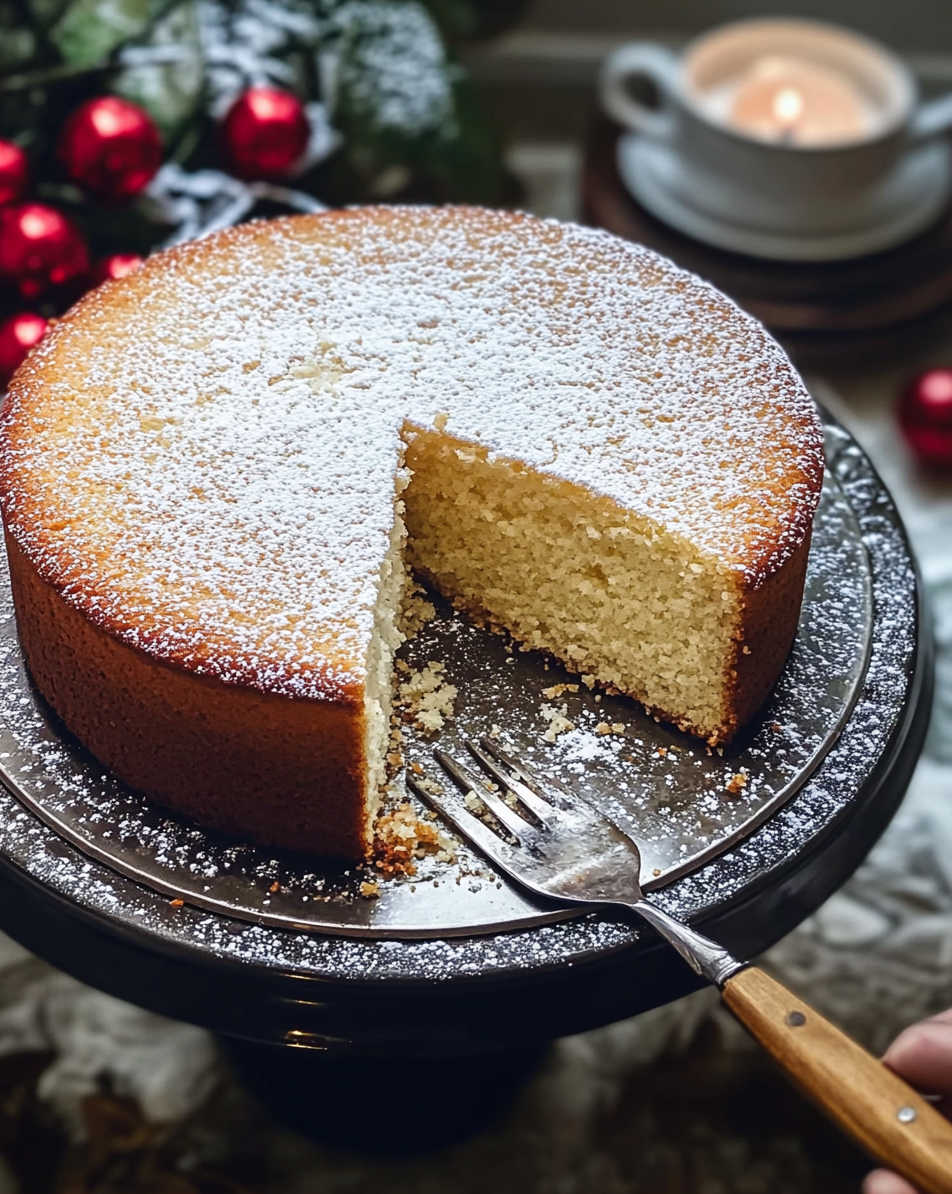Vasilopita is a traditional Greek New Year’s cake with a rich history and a deliciously light, citrusy flavor. The cake is soft and buttery, infused with fresh orange zest and a hint of vanilla, making it the perfect way to ring in the New Year. But the most exciting part is the hidden coin baked into the cake. Whoever finds it in their slice is believed to be blessed with good luck for the coming year—a fun and festive tradition for family and friends.
Whether you’re celebrating with a large group or a cozy family gathering, Vasilopita adds a special touch to the New Year. The light dusting of powdered sugar on top creates a beautiful finish, while the blend of citrus and vanilla flavors brings warmth and brightness to the dessert table. It’s a recipe filled with tradition, meaning, and plenty of love, making it an essential part of the Greek New Year celebration.
Full Recipe:
- 3 cups all-purpose flour
- 1 tablespoon baking powder
- 1/2 teaspoon baking soda
- 1/2 teaspoon salt
- 1/2 cup butter, softened
- 2 cups sugar
- 3 eggs
- 1 cup plain yogurt
- 1/2 cup milk
- 2 teaspoons vanilla extract
- 1/4 cup orange juice
- Zest of 1 orange
- Powdered sugar for dusting
Directions:
- Preheat the oven to 350°F (175°C) and grease a 10-inch round cake pan.
- In a medium bowl, combine flour, baking powder, baking soda, and salt.
- In a separate large bowl, cream together the butter and sugar until light and fluffy. Add the eggs one at a time, beating well after each addition.
- Stir in the yogurt, milk, vanilla extract, orange juice, and orange zest.
- Gradually add the dry ingredients to the wet ingredients, mixing until just combined.
- Pour the batter into the prepared cake pan and bake for 45-60 minutes, or until a toothpick inserted into the center comes out clean.
- Allow the cake to cool completely in the pan, then transfer to a serving plate. Dust with powdered sugar before serving.
- Tradition holds that a coin is baked into the cake. If following this tradition, wrap a clean coin in foil and place it into the batter before baking. Whoever finds the coin is said to have good luck for the year!
Prep Time: 20 minutes | Cooking Time: 50 minutes | Total Time: 1 hour 10 minutes
Kcal: 350 kcal per serving | Servings: 12 servings
Vasilopita, or Greek New Year’s Cake, is a deeply symbolic and traditional dessert served in many Greek households to celebrate the arrival of the new year. The name “Vasilopita” means “St. Basil’s Cake,” named after Saint Basil, one of the great figures of early Christianity. This cake is baked to honor his feast day, which falls on January 1st, and it carries a unique tradition—hiding a coin inside the cake. The person who finds the coin in their slice is said to receive good luck and blessings for the entire year.
Historical Background
The origins of Vasilopita date back to a legend about Saint Basil. According to the story, Saint Basil once helped the people of his city collect money and valuable items to pay off an oppressive tax imposed by a ruler. When the ruler canceled the tax, Saint Basil needed to return the wealth. To distribute it fairly, he had bread baked with coins and jewelry hidden inside, and each person who received a loaf found their rightful belongings. Over time, this tradition was adapted into the New Year’s custom, where the coin represents prosperity, fortune, and blessings.
Key Ingredients and Variations
Vasilopita is typically made with simple ingredients such as flour, sugar, eggs, yogurt, orange zest, and sometimes, a touch of vanilla. These ingredients give the cake a soft, tender texture and a light citrus flavor that pairs well with its slightly sweet profile. In some versions, almond or mahleb (an aromatic spice made from cherry seeds) is added for an extra dimension of flavor.
There are two primary types of Vasilopita:
- Cake Version (as described in this recipe): A fluffy, citrus-infused cake that is commonly prepared in many regions of Greece.
- Bread Version: A yeast-based sweet bread similar to a brioche, often made with flavors like orange, cinnamon, and almonds.
The Tradition of the Coin
One of the most fun and cherished aspects of Vasilopita is baking a coin (usually wrapped in foil) into the cake. This hidden coin symbolizes the luck and prosperity for the person who finds it in their piece. It’s a beloved family ritual to see who gets the lucky slice, and some families even award a special prize or blessing to the person who finds the coin.
Symbolism and Celebration
Vasilopita is typically cut at the stroke of midnight on New Year’s Eve or during a family gathering on New Year’s Day. The first slice is usually dedicated to Jesus Christ, the second to the house, and then slices are distributed to family members, starting with the eldest. The excitement of searching for the coin adds a festive and communal spirit to the occasion.
Serving and Enjoying Vasilopita
This cake is often served with a light dusting of powdered sugar or a glaze for extra sweetness, though it is not overly sweet itself, making it a perfect treat for those who prefer lighter desserts. It’s enjoyed with coffee or tea, and its citrus notes make it feel refreshing, even during the cooler winter months.
Regional Variations Across Greece
While the basic concept of Vasilopita remains the same, the recipe and presentation can vary greatly depending on the region of Greece and personal family traditions. Here are some regional differences that might interest your readers:
- Peloponnese: In this region, the cake version of Vasilopita is more popular. The recipe often includes anise seeds or mastiha (a resinous spice from the island of Chios) for added flavor. The cake is often decorated with nuts, such as almonds, arranged in a cross shape or to spell out the year.
- Northern Greece: In places like Thessaloniki, the bread version of Vasilopita (resembling tsoureki, the Easter bread) is more common. The bread is rich, sweet, and flavored with spices like cinnamon and cloves. This version may be braided and topped with sesame seeds.
- Cyclades (Islands): On the Greek islands, Vasilopita is sometimes more like a traditional Greek phyllo pastry. The dough may be layered with sweetened nuts or honey, reflecting influences from the island’s proximity to the Middle East.
Symbolism of the Coin and Slices
Beyond the simple tradition of finding the coin for good luck, the custom of slicing the Vasilopita is deeply symbolic. Here’s how some families approach the cutting:
- First Slice for Christ: As a form of blessing, the first slice of the cake is often dedicated to Christ.
- Second Slice for the House: The second slice is for the house, symbolizing protection and good fortune for the home.
- Slices for the Family: Then, the head of the household distributes slices to each member of the family, starting with the eldest. It’s a meaningful way to gather loved ones and share the joy of a new beginning together.
Modern Interpretations
As Greek cuisine has gained popularity around the world, many people outside of Greece have adopted Vasilopita into their own holiday traditions. This has led to some modern and creative twists on the recipe:
- Chocolate Vasilopita: Some bakers have begun to incorporate chocolate chips or a cocoa swirl into the batter to give the cake a richer, more decadent flavor.
- Health-Conscious Versions: With the rise of dietary preferences, gluten-free and dairy-free versions of Vasilopita have also become popular. Bakers substitute almond or coconut flour for all-purpose flour, and use plant-based milk and butter alternatives to cater to vegan and gluten-sensitive guests.
- Decorative Variations: The tradition of writing the year on top of the Vasilopita with almonds or powdered sugar remains popular, but some modern bakers have taken it a step further, decorating the cake with elaborate icing, gold leaf, or edible flowers to make it a true showpiece for holiday tables.
The Connection Between Vasilopita and St. Basil
The cake is named after Saint Basil the Great, a fourth-century bishop and one of the most important figures in Eastern Orthodox Christianity. Saint Basil is known for his kindness and generosity, particularly toward the poor. He established some of the earliest charitable institutions, including hospitals, orphanages, and schools, and is often referred to as the “Father of the Poor.” This connection to Saint Basil makes Vasilopita a symbol not only of good fortune but also of giving back and generosity.
In Greece, New Year’s Day is also St. Basil’s Day, which is why the cake is baked and enjoyed in his honor. It’s a reminder of his teachings, and many people use this day to make charitable donations or help those in need, reflecting the values of Saint Basil himself.
Additional Traditions and Superstitions
For those unfamiliar with Greek culture, it’s interesting to note that Vasilopita is more than just a cake—it’s part of a larger set of New Year’s traditions in Greece:
- “Podariko” (First Footing): The first person to step into the home after midnight is believed to bring the household luck for the coming year. It’s often a family member who is considered particularly fortunate.
- Lucky Coins in Other Traditions: While Vasilopita is a unique Greek custom, the tradition of hiding a coin or trinket in a holiday dish is shared by other cultures. For example, in some Latin American countries, a hidden figurine in a Rosca de Reyes (King’s Cake) is believed to bring luck.
Vasilopita in Greek-American Communities
In Greek-American communities, Vasilopita remains a strong tradition, often passed down through generations. Churches, schools, and community organizations hold Vasilopita cutting ceremonies, where slices are shared with parishioners and students. This has helped to keep the tradition alive for younger generations who may be growing up far from their ancestral homes.
At large gatherings, a portion of the cake is sometimes cut for symbolic figures, such as “the poor” or “the church”, emphasizing the community aspect of the tradition. Many families also donate a portion of their proceeds from these gatherings to charity, reinforcing the idea of Saint Basil’s generosity.
Health Benefits
Although Vasilopita is often enjoyed as a treat, the traditional ingredients in this cake offer some surprising health benefits:
- Orange Zest: Rich in vitamin C and antioxidants, the orange zest not only adds a bright, refreshing flavor but also contributes to immune system support.
- Greek Yogurt: Adding Greek yogurt to the batter provides a boost of protein and probiotics, which are beneficial for gut health.
- Whole Wheat Versions: Some variations use whole wheat flour for added fiber and a healthier twist on the classic recipe.
Serving Suggestions
- With Coffee or Tea: Vasilopita pairs beautifully with a hot cup of Greek coffee or herbal tea. The slightly tangy notes from the yogurt and orange zest complement the bitterness of a strong coffee.
- Breakfast Option: Leftover slices of Vasilopita make an excellent breakfast treat, especially when warmed slightly and served with a dollop of Greek yogurt or a drizzle of honey.
- Holiday Brunch: This cake can also be a stunning centerpiece for a New Year’s Day brunch, served alongside fresh fruits, nuts, and cheeses for a complete meal.
Conclusion
Vasilopita is more than just a New Year’s dessert—it’s a rich Greek tradition filled with symbolism, history, and a bit of luck. Whether you’re savoring the cake’s citrusy flavor or partaking in the joyful ritual of finding the hidden coin, this beloved tradition brings family and friends together to welcome the new year with good fortune and delicious food. Adding this cultural delight to your celebration is a flavorful way to honor the past and look forward to a prosperous future.






